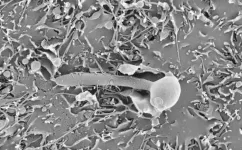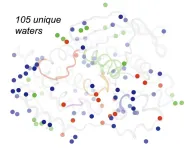(Press-News.org) Newcastle University research turns to ancient hot springs to explore the origins of life on Earth.
The research team, funded by the UK’s Natural Environmental Research Council, investigated how the emergence of the first living systems from inert geological materials happened on the Earth, more than 3.5 billion years ago. Scientists at Newcastle University found that by mixing hydrogen, bicarbonate, and iron-rich magnetite under conditions mimicking relatively mild hydrothermal vent results in the formation of a spectrum of organic molecules, most notably including fatty acids stretching up to 18 carbon atoms in length.
Published in the journal Communications Earth & Environment, their findings potentially reveal how some key molecules needed to produce life are made from inorganic chemicals, which is essential to understanding a key step in how life formed on the Earth billions of years ago. Their results may provide a plausible genesis of the organic molecules that form ancient cell membranes, that were perhaps selectively chosen by early biochemical processes on primordial Earth.
Fatty acids in the early stages of life
Fatty acids are long organic molecules that have regions that both attract and repel water that will automatically form cell-like compartments in water naturally and it is these types of molecules that could have made the first cell membranes. Yet, despite their importance, it was uncertain where these fatty acids came from in the early stages of life. One idea is that they might have formed in the hydrothermal vents where hot water, mixed with hydrogen-rich fluids coming from underwater vents mixed with seawater containing CO2.
The group replicated crucial aspects of the chemical environment found in early Earth's oceans and the mixing of the hot alkaline water from around certain types of hydrothermal vents in their laboratory. They found that when hot hydrogen-rich fluids were mixed with carbon dioxide-rich water in the presence of iron-based minerals that were present on the early Earth it created the types of molecules needed to form primitive cell membranes.
Lead author, Dr Graham Purvis, conducted the study at Newcastle University and is currently a Postdoctoral Research Associate at Durham University.
He said: “Central to life's inception are cellular compartments, crucial for isolating internal chemistry from the external environment. These compartments were instrumental in fostering life-sustaining reactions by concentrating chemicals and facilitating energy production, potentially serving as the cornerstone of life's earliest moments.
The results suggest that the convergence of hydrogen-rich fluids from alkaline hydrothermal vents with bicarbonate-rich waters on iron-based minerals could have precipitated the rudimentary membranes of early cells at the very beginning of life. This process might have engendered a diversity of membrane types, some potentially serving as life's cradle when life first started. Moreover, this transformative process might have contributed to the genesis of specific acids found in the elemental composition of meteorites.”
Principal Investigator Dr Jon Telling, Reader in Biogeochemistry, at School of Natural Environmental Sciences, added:
“We think that this research may provide the first step in how life originated on our planet. Research in our laboratory now continues on determining the second key step; how these organic molecules which are initially ‘stuck’ to the mineral surfaces can lift off to form spherical membrane-bounded cell-like compartments; the first potential ‘protocells’ that went on to form the first cellular life.”
Intriguingly, the researchers also suggest that membrane-creating reactions similar reactions, could still be happening in the oceans under the surfaces of icy moons in our solar system today. This raises the possibility of alternative life origins in these distant worlds.
Reference
Purvis, G., Šiller, L., Crosskey, A. et al. Generation of long-chain fatty acids by hydrogen-driven bicarbonate reduction in ancient alkaline hydrothermal vents. Commun Earth Environ 5, 30 (2024). https://doi.org/10.1038/s43247-023-01196-4
--ends--
END
Study uncovers potential origins of life in ancient hot springs
2024-01-12
ELSE PRESS RELEASES FROM THIS DATE:
Nutritional acquired immunodeficiency (N-AIDS) is the leading driver of the TB pandemic
2024-01-12
(Boston)—Tuberculosis (TB) is the leading infectious killer worldwide, with 10.6 million cases and 1.6 million deaths in 2021 alone. One in five incident TB cases were attributable to malnutrition, more than double the number attributed to HIV/AIDS. Like HIV/AIDS, malnutrition is a cause of secondary immunodeficiency, known as nutritionally acquired immunodeficiency syndrome (N-AIDS). However, N-AIDS remains the neglected cousin of HIV/AIDS in global TB elimination efforts.
In a review paper led by Madolyn Dauphinais, MPH, researchers at Boston University Chobanian ...
Obesity linked to detection of blood cancer precursor
2024-01-12
(WASHINGTON, January 12, 2024) – Individuals with obesity are more likely to have monoclonal gammopathy of undetermined significance (MGUS), a benign blood condition that often precedes multiple myeloma, according to new research published in Blood Advances.
Multiple myeloma is a blood cancer of the plasma cells, a type of white blood cells that produce antibodies to fight infection. MGUS, characterized by an abnormal protein produced by plasma cells, is a known precursor to multiple myeloma. Most people with MGUS exhibit no significant symptoms and are not immediately ill. Rather, the presence of MGUS serves as a warning to monitor for the potential ...
How gum disease aggravates chronic obstructive pulmonary disease
2024-01-12
Highlights:
Previous studies have connected severe gum disease to chronic obstructive pulmonary disease, or COPD.
Bacteria play a critical role, but the details remain unclear.
A new study shows how periodontitis, an oral disease, activates immune cells associated with aggravated progression of COPD.
The findings suggest that periodontitis and COPD together worsen COPD, and point to gum disease management as a potential treatment for COPD.
Washington, D.C.—Severe gum disease has been linked to the progression of chronic obstructive pulmonary disease, or COPD, but an understanding ...
ASM expands clinically relevant research with launch of ASM Case Reports
2024-01-12
Washington, D.C.—The American Society for Microbiology (ASM) announces the launch of its new fully open access journal, ASM Case Reports, which will begin publishing case reports in 2025 and accepting submissions starting mid-2024. ASM Case Reports will be a dedicated platform for the prompt publication of high-quality case reports in clinical microbiology and infectious diseases, an extensive and rapidly growing body of research.
ASM Case Reports will explore new diseases, elaborate disease progressions, the detailed actions and effects of pharmaceuticals, ...
Rice researchers revolutionizing 5G network testing
2024-01-12
With the potential to transform the future of global wireless networks, Rice University engineers are developing a cutting-edge testing framework to assess the stability, interoperability, energy efficiency and communication performance of software-based machine learning-enabled 5G radio access networks (RANs).
As 5G networks evolve toward more software-centric architectures, there is a critical need for advanced testing methods to ensure robust real-time performance. Funded by a $1.9 million grant from the U.S. Department of Commerce’s National Telecommunications and Information ...
Candida evolution disclosed: new insights into fungal infections
2024-01-12
Barcelona, 12 January 2024 – Global fungal infections, which affect one billion people and cause 1.5 million deaths each year, are on the rise due to the increasing number of medical treatments that heighten vulnerability. Patients undergoing chemotherapy or immunosuppressive treatments after organ transplant often present compromised immune systems. Given the emergence of resistant strains, the limited variety of current antifungal drugs as well as their cost and side effects, the treatment of these infections is challenging and brings about an urgent need for more effective treatments.
In this context, a team from the Institute for ...
Study reveals function of little-understood synapse in the brain
2024-01-12
New research from Oregon Health & Science University for the first time reveals the function of a little-understood junction between cells in the brain that could have important treatment implications for conditions ranging from multiple sclerosis to Alzheimer’s disease, to a type of brain cancer known as glioma.
The study published today in the journal Nature Neuroscience.
Neuroscientists focused on the junction, or synapse, connecting neurons to a non-neuronal cell, known as oligodendrocyte precursor cells, or OPCs. OPCs can differentiate into oligodendrocytes, which produce a sheath around nerves known as myelin. Myelin is ...
Spying on a shape-shifting protein
2024-01-12
NEW YORK, January 12, 2024 — Proteins do the heavy lifting of performing biochemical functions in our bodies by binding to metabolites or other proteins to complete tasks. To do this successfully, protein molecules often shape-shift to allow specific binding interactions that are needed to perform complex, precise chemical processes.
A better understanding of the shapes proteins take on would give researchers important insight into stopping or treating diseases, but current methods for revealing these dynamic, three-dimensional forms offer scientists limited information. To address this knowledge ...
Researchers sequence the first genome of myxini, the only vertebrate lineage that had no reference genome
2024-01-12
An international scientific team made up of more than 40 authors from seven different countries, led by the researcher at the University of Malaga Juan Pascual Anaya, has managed to sequence the first genome of the myxini –also known as ‘hagfish’–, the only large group of vertebrates for which there was no reference genome of any of its species yet.
This finding, published in the scientific journal ‘Nature Ecology & Evolution’, has allowed deciphering the evolutionary history of genome duplications –number of times a ...
Researchers uncover blood flow regulation of brain pericyte development
2024-01-12
In a study published online in Cell Reports, DU Jiulin’s group at the Institute of Neuroscience, Center for Excellence in Brain Science and Intelligence Technology of the Chinese Academy of Sciences, and the collaborators, created a zebrafish model for in vivo labeling of brain pericytes and systematically explored the developmental dynamics of brain pericytes during the early embryonic stage. The researchers revealed the promoting effect of blood flow on the proliferation of pericytes after ingress into the brain and showed that this process ...


